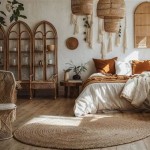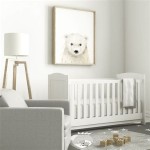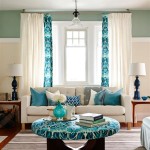Small Drawing Room Decorating Ideas
Decorating a small drawing room presents a unique set of challenges and opportunities. The goal is to create a space that feels both welcoming and functional, maximizing the perceived square footage while reflecting the homeowner's personal style. Careful planning and thoughtful execution are crucial for achieving a comfortable and aesthetically pleasing result. This article explores several key strategies and design elements to effectively decorate a small drawing room.
Optimizing Space Through Furniture Selection
The selection of furniture is paramount in a small drawing room. Overly large or bulky pieces can quickly overwhelm the space, making it feel cramped and claustrophobic. Opting for smaller-scale furniture is essential for maintaining a sense of openness. Consider furniture with clean lines and minimal ornamentation. These designs tend to visually recede, contributing to a less cluttered appearance.
Multi-functional furniture is a key element in space optimization. A sofa bed, for instance, can serve as a comfortable seating option during the day and transform into a guest bed at night. Similarly, coffee tables with built-in storage can provide a convenient place to stow away magazines, remote controls, and other items, reducing surface clutter. Ottomans with lift-up lids offer additional storage solutions while also functioning as extra seating or footrests.
Wall-mounted shelves and cabinets are effective for maximizing vertical space. They provide storage and display areas without occupying valuable floor space. When selecting shelves, consider using light-colored finishes to further enhance the feeling of spaciousness. Floating shelves, in particular, create a minimalist and airy look.
Avoid using too many pieces of furniture. A carefully curated selection of essential items is preferable to crowding the room with unnecessary pieces. Choose a focal point, such as a comfortable sofa or a striking armchair, and build the rest of the room around it. Leave ample space for movement and circulation to prevent the room from feeling cramped.
When selecting seating, consider chairs with exposed legs. This allows the eye to see more of the floor, creating the illusion of a larger space. Sofas and chairs with low backs can also contribute to a feeling of openness, as they do not block the view as much as high-backed furniture.
Employing Color and Light to Enhance Space
Color and light are powerful tools for transforming the perception of space in a small drawing room. Light colors tend to reflect light, making a room feel brighter and more spacious. Dark colors, on the other hand, absorb light and can make a room feel smaller and more enclosed. Therefore, it is generally advisable to use light and neutral colors for the walls and larger furniture pieces in a small drawing room.
Consider using a monochromatic color scheme, where different shades and tints of a single color are used throughout the room. This creates a sense of unity and cohesiveness, which can make the space feel larger. Accents of brighter colors can be incorporated through accessories, such as throw pillows, artwork, and decorative objects, to add visual interest and prevent the room from feeling monotonous.
Natural light is a crucial element in creating a bright and airy atmosphere. Maximize the amount of natural light entering the room by keeping windows unobstructed. Avoid using heavy curtains or blinds that block light. Instead, opt for sheer curtains or light-colored blinds that allow light to filter through while still providing privacy.
Artificial lighting is also essential, especially in rooms that do not receive ample natural light. Use a combination of ambient, task, and accent lighting to create a well-lit and inviting space. Ambient lighting, such as overhead fixtures or floor lamps, provides general illumination. Task lighting, such as table lamps or reading lights, provides focused light for specific activities. Accent lighting, such as spotlights or wall sconces, highlights architectural features or artwork.
Mirrors are a well-known trick for creating the illusion of space. Placing a large mirror on a wall can effectively double the perceived size of the room. Strategically position mirrors to reflect light and create depth. Consider placing a mirror opposite a window to maximize the amount of natural light reflected into the room.
Utilizing Décor and Accessories Strategically
The choice and placement of décor and accessories can significantly impact the overall feel of a small drawing room. A minimalist approach is generally preferable, avoiding excessive clutter and focusing on a few carefully selected items that enhance the space without overwhelming it. Consider each item's purpose and visual weight before incorporating it into the room.
Artwork can add personality and visual interest to a small drawing room. However, it is important to choose artwork that is appropriately scaled to the size of the room. Large, bold pieces can overwhelm a small space, while small, scattered pieces can feel disjointed. Consider using a gallery wall of smaller, framed prints to create a focal point without taking up too much space.
Rugs can define different areas within the room and add warmth and texture. In a small drawing room, it is generally advisable to choose a rug that is large enough to anchor the main seating area. A rug that is too small can make the room feel smaller and less cohesive.
Throw pillows and blankets can add comfort and style to a sofa or armchair. Choose fabrics and colors that complement the overall color scheme of the room. Avoid using too many pillows, as they can make the seating area feel cluttered and uncomfortable.
Plants can bring life and freshness to a small drawing room. Choose plants that are appropriate for the amount of light available in the room. Consider using hanging planters or wall-mounted planters to save floor space. Succulents and air plants are low-maintenance options that can add a touch of greenery without requiring much care.
Pay attention to details such as hardware and trim. Replacing outdated or mismatched hardware with sleek, modern options can instantly elevate the look of the room. Painting the trim in a contrasting color can add visual interest and define the architectural features of the space.
Avoid displaying too many personal items or collections. While it is important to personalize the space, excessive clutter can make a small drawing room feel cramped and overwhelming. Rotate your displays periodically to keep the room feeling fresh and avoid visual fatigue. Consider storing items that are not currently on display in a closet or storage unit.
By carefully considering furniture selection, color and light, and décor and accessories, it is possible to create a small drawing room that is both functional and aesthetically pleasing. The key is to maximize space, minimize clutter, and create a sense of openness and light. Thoughtful planning and careful execution can transform a small drawing room into a welcoming and comfortable space that reflects the homeowner's personal style.

10 Stunning Small Living Room Ideas To Maximize Space

Small Living Room Decorating Ideas Designcafe

5 Stunning Drawing Room Designs And Decor Ideas By Livspace

15 Latest Drawing Room Design Ideas Designcafe

How To Decorate A Small Drawing Room

How To Decorate A Small Drawing Room

Seven Effective Drawing Room Decoration Ideas Design Cafe

Drawing Room Interior Design Ideas Blog Designcafe

How To Decorate A Small Living Room Maximise Tiny Space Forbes Home

Small Bedroom Ideas To Maximise Space And Style By Livspace







